
The Kingdom of Saudi Arabia does not export Zamzam Water. It is one of the products whose export is prohibited pursuant to the laws of the Kingdom. However, every Hajj and Umrah performer is allowed to take one bottle of Zamzam Water that is specifically prepared for travel. However, Zamzam Water export as goods is prohibited. Zamzam Water is produced at a bottling plant (King Abdullah Bin Abdulaziz Zamzam Watering Project), established in 2010 and valued at SAR700 million. The project aims to ...

Zamzam Well is thirty m deep. It features a built part whose depth is estimated at 12.80 m and another part drilling in the mountain's rock over a distance of 17.20 m. Its diameter varies between 1.5 and 2.5 m. Kings of the Kingdom of Saudi Arabia took care of Zamzam Well throughout various eras. They were keen on its improvement and development since the reign of the Founding King Abdulaziz Bin Abdulrahman Al Saud. During his reign, buckets were used for extracting water from the well unt...

To ensure the purity of Zamzam water, a set of procedures is undertaken, including: Pumping it in a closed circuit through rust-resistant pipes. Passing it through specialized filters to trap sand and impurities. Transferring it to chemically treated tanks to prevent bacterial activities. Conducting a series of chemical and bacteriological analyses before using the water. Requiring health certificates for all Zamzam water service employees to ensure they are disease-free. Cleaning the bases of ...
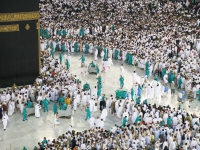
The Grand Mosque is cleaned using specially manufactured disinfectants designed for use within its halls. It is washed ten times daily, with the cleaning handled by more than four thousand workers. Each day, over 150,000 l of disinfectants are used. Staff circulate throughout the prayer halls and corridors with incense burners emitting the fragrant scent of oud for perfuming the Grand Mosque. Al-Kaaba and its elements are anointed with oud oil before every prayer. Additionally, prayer rugs are ...
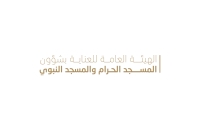
The Grand Mosque Mediation and Moderation Academy was established by the General Presidency for the Affairs of the Two Holy Mosques (currently the General Authority for the Care of the Affairs of the Grand Mosque and the Prophet’s Mosque) on January 27, 2021. The Grand Mosque Mediation and Moderation Academy strives to achieve many goals, including: Fostering correct thinking among members of the Islamic nation, promoting upright behavior based on the Holy Quran and the Sunnah of the Prophet,...
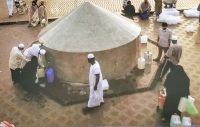
The Zamzam Well originated when Prophet Ibrahim, peace be upon him (PBUH), came to Makkah al-Mukarramah and left his wife Hajar and his son Ismail in a valley with no vegetation or water. When Hajar's water supply ran out, her child began to writhe from thirst. She hurried between Safa and Marwah, searching for help, until she heard a sound at the site of the well. It was Jibril (PBUH) who caused the spring to gush forth, and the mother of Ismail contained the water and scooped from it. Th...

The idea of creating courtyards for the Grand Mosque began during the first Saudi expansion in 1955. This expansion included the construction of new architecture for the mosque, the provision of support for its structures, and the addition of open courtyards that increased its area and provided more options for visitors and pilgrims coming to the Grand Mosque. The number of courtyards in the first and second Saudi expansions reached seven, with a total area of all the courtyards around the Gran...
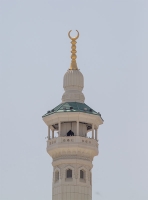
The number of minarets at the Grand Mosque is nineteen, each with a height of eighty-nine m. There were five minarets before the Saudi era, and the number increased to seven during the first Saudi expansion. The building of the second Saudi expansion included two new minarets, each with a height of eighty-nine m, designed architecturally to resemble the previous seven minarets. The number of minarets reached thirteen in the third Saudi expansion , and currently, construction and architectur...
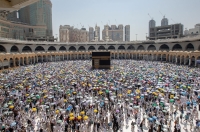
The capacity of Mataf in the Grand Mosque is 107,000 pilgrims per hour, equivalent to over double its previous capacity which was limited to fifty thousand pilgrims. The first phase of Mataf expansion project commenced in 2013. The expansion process included three phases over three years, concluding in 2015. The total constructed area comprising all the project's elements and components is estimated at 210,000 m 2 . Mataf comprises several floors featuring designated locations for wheelcha...

The process of purifying and sterilizing Zamzam water is carried out by using two large pumps that draw water from the well to the King Abdullah Project for Zamzam Water Development. The water is transported through rust-resistant pipes that pass through air and washing chambers to protect the water from any potential contaminants. Zamzam water is transferred to a dedicated station for filtration, purification, and sterilization. Samples are taken and subjected to analysis to verify the water&#...
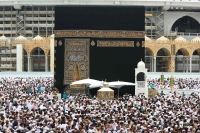
Al-Kaaba al-Musharrafa, located in the Grand Mosque in Makkah al-Mukarramah , is washed on the fifteenth of Muharram each Hijri year. Before the washing, it is cleaned with four straw brooms that have silver handles, used to sweep away dust. These brooms are inscribed with the phrase: 'This is the glorious Kaaba, how fragrant is its aroma and how pure are the walls washed with light.' A set of tools and copper vessels are used to wash al-Kaaba al-Musharrafa, in addition to four ten-l ...
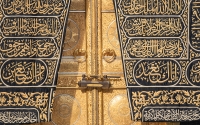
The quantity of gold in the door of al-Kaaba al-Musharrafa and Bab al-Tawbah (Door of Repentance), which is located at the northeast corner inside al-Kaaba, is estimated to be around 280 kg, all of which is 999.9 percent pure. The total cost of manufacturing these two doors, excluding the quantity of gold used in them, is approximately SAR13,420,000. The design and manufacture of a new door for al-Kaaba al-Musharrafa were carried out on the directive of King Khalid Bin Abdulaziz Al Saud in 1977...